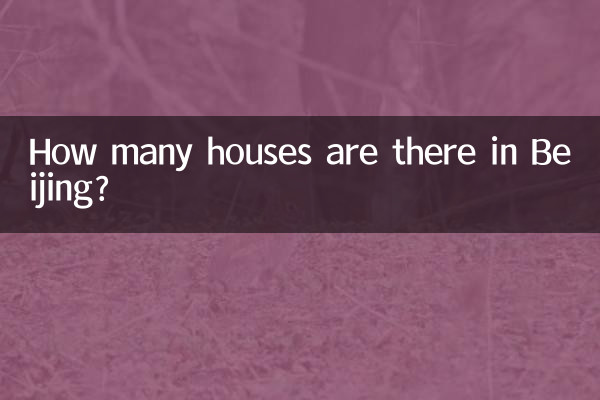How many houses are there in Beijing? Demystifying urban housing data and hot topics
Recently, Beijing’s housing issue has once again become the focus of heated discussions across the Internet. With housing price fluctuations, policy adjustments and population mobility, people are curious about Beijing's housing stock, vacancy rate and future trends. This article will combine the hot topics on the Internet in the past 10 days and analyze the current housing situation in Beijing through structured data.
1. Total housing stock in Beijing: official data and private estimates

According to public information from the Beijing Municipal Bureau of Statistics and the Housing and Urban-Rural Development Commission, as of 2023, Beijing’s total housing stock will be approximately8 million sets, of which commercial housing accounts for about 60%, and affordable housing and old communities account for 40%. The following is a detailed classification:
| housing type | Quantity (10,000 sets) | Proportion |
|---|---|---|
| commercial housing | 480 | 60% |
| affordable housing | 200 | 25% |
| Old community | 120 | 15% |
It is worth noting that the total housing stock estimated by private organizations may be higher. Some studies believe that including houses with small property rights and unregistered housing, Beijing’s actual housing stock may be close to10 million sets.
2. Beijing housing vacancy rate: controversy and truth
Regarding the housing vacancy rate in Beijing, data from various parties vary greatly. In recent hot discussions, the following two types of views are more prominent:
| Data source | vacancy rate | Remark |
|---|---|---|
| official report | 5%-8% | Based on electricity consumption sampling survey |
| folk research | 10%-15% | Covers suburban and investment properties |
Experts pointed out that the difference in vacancy rates mainly stems from different statistical methods and scopes. For example, the vacancy phenomenon of new houses and houses in school districts is more obvious in outer suburbs, while the vacancy rate is lower in core urban areas.
3. Hot topics on the Internet in the past 10 days
Combined with the popularity of social media and news platforms, the following topics are closely related to Beijing housing:
| Ranking | topic | heat index |
|---|---|---|
| 1 | The effect of the policy of “Recognize a house but not a loan” | 985,000 |
| 2 | Second-hand housing listings in Beijing exceed 160,000 | 872,000 |
| 3 | Housing prices in school districts fell by more than 20% | 768,000 |
4. Future Trends: Supply and Demand Relationship and Policy Impact
Beijing's housing market is facing a restructuring of supply and demand. On the one hand, the population dispersal policy has slowed down the growth of housing demand; on the other hand, the construction of affordable housing has accelerated. It is expected that by 2025, Beijing will add new300,000 setsAffordable rental housing further balances the market.
In addition, policy trends such as property tax pilots and the promotion of shared property housing may also have a profound impact on the efficiency of housing stock utilization.
Conclusion
The housing issue in Beijing is not only a discussion at the data level, but also related to urban development and residents’ quality of life. Judging from current data, the total housing supply is sufficient but the structure is uneven. In the future, policy optimization will be needed to achieve a reasonable allocation of resources. What is your opinion on the current housing situation in Beijing? Welcome to participate in the discussion!

check the details

check the details